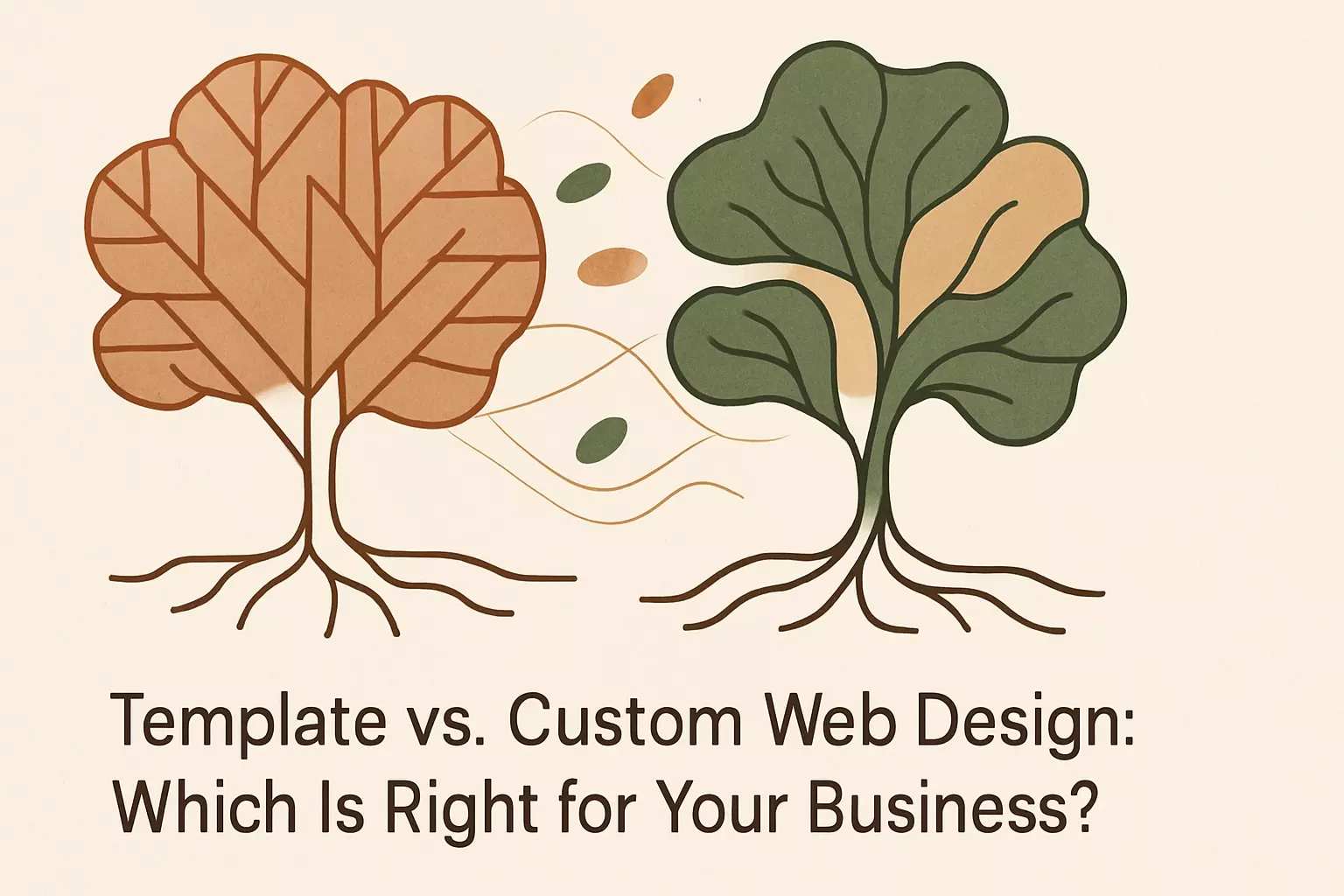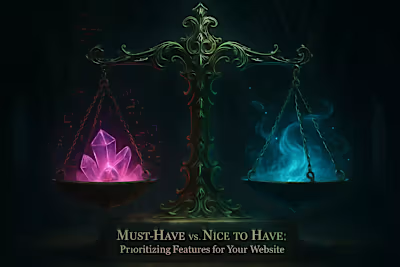Template vs. Custom Web Design: Which Is Right for Your Business?

Template vs. Custom Web Design: Which Is Right for Your Business?
The Case for Website Templates
Advantages of Using a Template
Disadvantages of Using a Template
Who Should Use a Template?
The Power of Custom Web Design
Advantages of a Custom Design
Disadvantages of a Custom Design
Who Should Invest in a Custom Design?
Making the Decision: Key Factors to Consider
Budget and Timeline
Brand Identity and Uniqueness
Functionality and Scalability
References
Template vs. Custom Web Design: Which Is Right for Your Business?
A pivotal decision in any website project is whether to use a pre-designed template or to build a custom design from the ground up. This choice significantly impacts your budget, timeline, and the final look and functionality of your site. Templates offer a quick and affordable solution, while custom designs provide unparalleled uniqueness and flexibility.
Understanding the trade-offs is essential, especially after deciding whether to work with a freelancer or an agency. Additionally, this decision is closely tied to whether you'll use a no-code platform or opt for custom coding.
The Case for Website Templates
Website templates are pre-made layouts that allow you to quickly launch a website by adding your own content and images. They're like the ready-to-assemble furniture of the web design world. You get a solid foundation that just needs your personal touch.
Think of templates as starting with a house that's already built. You can paint the walls, change the furniture, and hang your pictures, but the basic structure stays the same. This approach has become incredibly popular with small businesses, blogs, and anyone who needs to get online fast without breaking the bank.
The template market has exploded in recent years. Platforms like WordPress, Squarespace, and Wix offer thousands of options for every industry imaginable. Whether you're opening a bakery or launching a consulting firm, there's probably a template designed just for your needs.
Advantages of Using a Template
The biggest advantages are cost and speed. Let's talk numbers for a second. A premium template might cost you anywhere from $50 to $200. Compare that to a custom design that can easily run into thousands of dollars. For many businesses, that's a game-changer.
Speed is equally impressive. With a good template, you can have a professional-looking website up and running in a matter of days, sometimes even hours. I've seen business owners launch their entire online presence over a weekend. Try doing that with a custom build!
Templates are also incredibly user-friendly. You don't need to know a single line of code to get started. Most come with drag-and-drop builders that make customization as easy as moving blocks around on your screen. Plus, you get reliable support from the template provider. If something breaks, there's usually a whole team ready to help you fix it.
Another huge benefit? Templates are tested across different browsers and devices. The developers have already done the heavy lifting to ensure your site looks good whether someone's viewing it on an iPhone or a desktop computer. That's hours of testing you don't have to worry about.
Disadvantages of Using a Template
But here's the catch - and it's a big one. The main drawback is limited customization. Your site may look similar to others using the same template, making it difficult to stand out. Imagine showing up to a party and seeing someone wearing the exact same outfit. That's what can happen with templates.
I once worked with a client who discovered their biggest competitor was using the same template. Talk about awkward! They had to scramble to differentiate their site, which ended up costing more time and money than they'd initially saved.
Templates can also have bloated code, which can slow down your site. All those features and options you might never use? They're still there in the background, potentially dragging down your load times. And we all know how impatient internet users can be. A slow site means lost visitors.
SEO limitations are another concern. While many templates claim to be SEO-friendly, they often fall short of what you can achieve with custom code. You might find yourself fighting against the template's structure when trying to optimize for search engines.
Scalability can become an issue too. As your business grows, you might find the template can't keep up with your needs. Adding custom features or integrations can be like trying to fit a square peg in a round hole.
Who Should Use a Template?
Templates are ideal for startups, small businesses, or projects with a limited budget and straightforward requirements. If you're just starting out and need to test your business idea, a template gets you in the game without a huge upfront investment.
They're perfect for businesses that need a web presence but don't rely heavily on their website for revenue. Think local restaurants, hair salons, or professional service providers who mainly need to share basic information and contact details.
If you need to get online quickly and don't require complex, unique features, a template is a practical choice. Maybe you have a product launch coming up or a time-sensitive campaign. Templates let you move fast without sacrificing too much quality.
The Power of Custom Web Design
Custom web design involves creating a website from scratch, tailored specifically to your brand's identity and business goals. It's like having a house built exactly to your specifications, from the foundation up. Every pixel, every interaction, every feature is designed with your specific needs in mind.
This approach offers complete creative freedom and a unique digital presence. You're not confined by someone else's design decisions or limited by pre-built structures. Want a navigation menu that transforms into a dancing unicorn when users hover over it? With custom design, anything's possible (though maybe stick to more practical features).
Custom design is about more than just looking different. It's about creating an experience that perfectly aligns with your brand values and user needs. Every element serves a purpose, every interaction is intentional.
Advantages of a Custom Design
A custom design perfectly reflects your unique brand identity. Your website becomes a true extension of your brand, not just a digital brochure. Colors, fonts, layouts, animations - everything works together to tell your brand's story in a way that's impossible to replicate.
Custom sites are built with scalability in mind, allowing them to grow with your business. Need to add an e-commerce section next year? Want to integrate with a specific CRM system? No problem. The foundation is built to accommodate whatever the future holds.
SEO optimization is baked in from day one. Clean, semantic code helps search engines understand your content better. Page load speeds are optimized because there's no unnecessary bloat. You have complete control over meta tags, schema markup, and site structure.
Performance is another major win. Custom sites have cleaner code for better performance because every line serves a purpose. There's no extra baggage from features you'll never use. This means faster load times, smoother interactions, and happier users.
You can also incorporate unique features not possible with templates. Maybe you need a custom calculator, an interactive product configurator, or integration with proprietary systems. Custom development makes these complex requirements achievable.
Disadvantages of a Custom Design
The primary disadvantages are the higher cost and longer development time. We're talking about a significant investment here. A basic custom website might start at $5,000, but complex projects can easily reach $50,000 or more.
Time is another factor. While you can launch a template site in days, custom projects typically take weeks or months. There's discovery, design, development, testing, and revision phases. Each step takes time to get right.
A custom project also requires more involvement from you. You'll need to provide detailed feedback, make decisions about features and functionality, and really think through your user experience. It's not a set-it-and-forget-it solution.
There's also the risk factor. With templates, you can see exactly what you're getting before you commit. With custom design, you're trusting the process and the team you've hired. Sometimes the final result doesn't match the vision, leading to costly revisions.
Who Should Invest in a Custom Design?
Businesses that want to establish a strong, unique brand presence and require specific functionalities should opt for a custom design. If your website is a critical part of your business model - maybe you're an e-commerce company or a SaaS provider - the investment makes sense.
Companies in competitive industries often need custom design to differentiate themselves. When everyone else is using templates, a custom site can be your secret weapon. It shows you're serious about your business and willing to invest in quality.
If you anticipate significant growth or need a competitive edge, a custom website is a valuable long-term investment. Think of it as buying quality tools for your trade. Sure, the cheap ones work, but the professional-grade equipment pays for itself over time.
Businesses with unique workflows or customer needs benefit hugely from custom design. Maybe you need a patient portal for your medical practice or a custom booking system for your tours. These specific requirements often justify the custom approach.
Making the Decision: Key Factors to Consider
Choosing between a template and a custom design comes down to balancing your budget, timeline, and business objectives. There's no one-size-fits-all answer. What works for your competitor might be completely wrong for you.
The decision should align with your overall business strategy. Are you bootstrapping a startup or scaling an established business? Is your website a digital business card or your primary revenue driver? These questions matter.
Consider where you want to be in five years. Sometimes it makes sense to start with a template and upgrade to custom later. Other times, investing in custom from the start saves money in the long run.
Budget and Timeline
If your budget is tight and you need to launch quickly, a template is the clear winner. There's no shame in starting small. Many successful businesses began with template websites and upgraded as they grew.
But think beyond the initial cost. Factor in potential redesign costs, lost opportunities from a generic appearance, and the cost of workarounds for missing features. Sometimes the "expensive" option is actually cheaper over time.
If you have the financial resources and time to invest in a long-term asset, a custom design is worth considering. It's like the difference between renting and buying a house. One gives you flexibility and low upfront costs, the other builds equity.
Create a realistic budget that includes not just design and development, but also maintenance, updates, and potential modifications. Custom sites often require ongoing developer support, while templates might include updates in their subscription.
Brand Identity and Uniqueness
How important is a unique brand identity for your business? If standing out from competitors is a top priority, a custom design is the superior choice. Remember, 75% of visitors judge a brand's credibility based on its web design. First impressions matter online.
Some industries demand uniqueness more than others. Creative agencies, design studios, and innovative tech companies often need custom sites to showcase their capabilities. Using a template might send the wrong message about their skills.
But uniqueness isn't always necessary. If you're a local plumber or accountant, your clients probably care more about finding your phone number quickly than admiring your creative web design. Know your audience and what matters to them.
Consider your brand's personality too. Is it bold and innovative or traditional and trustworthy? Your website should reflect these qualities, and sometimes templates can't capture the nuances of your brand voice.
Functionality and Scalability
Consider your future needs carefully. Will you need to add complex features or handle a large increase in traffic? A custom website offers the flexibility and scalability that templates often lack. But be realistic about your growth projections.
Think about integrations too. Do you need your website to talk to your inventory system, CRM, or email marketing platform? Custom development often handles these integrations more smoothly than trying to force a template to play nice with your other tools.
User experience requirements matter as well. If your customers need to complete complex tasks on your site, custom design can streamline these processes in ways templates can't match. Every click saved is a potential conversion gained.
Don't forget about maintenance and updates. Templates often handle security updates and bug fixes automatically. With custom sites, you'll need a plan for ongoing maintenance. Factor this into your decision-making process.
The mobile experience is crucial too. While most templates are mobile-responsive these days, custom design can optimize the mobile experience in ways that truly enhance usability. If most of your traffic comes from mobile devices, this could tip the scales.
Data and analytics needs should also influence your decision. Custom sites can implement sophisticated tracking and analytics that go beyond basic template offerings. If data-driven decision making is core to your business, custom might be the way to go.
Finally, think about content management. How often will you update your site? Who will do it? Templates often come with user-friendly content management systems, while custom sites might require more technical knowledge for updates. Choose based on your team's capabilities.
Making the right choice between template and custom web design isn't just about today's needs - it's about positioning your business for tomorrow's opportunities. Take time to evaluate all factors, consult with professionals if needed, and make a decision that aligns with your long-term vision.
Whether you choose a template or custom design, remember that your website is often the first interaction potential customers have with your brand. Make it count. Invest appropriately based on your business goals, and don't be afraid to start small and grow over time.
The best website is one that serves your customers effectively and helps you achieve your business objectives. Sometimes that's a template, sometimes it's custom, and sometimes it's a journey that starts with one and evolves to the other. What matters most is making an informed decision that sets your business up for success.
References
Like this project
Posted Jun 30, 2025
Should you use a pre-made template or invest in a custom web design? Discover the pros, cons, and key differences to make the best decision for your website.











